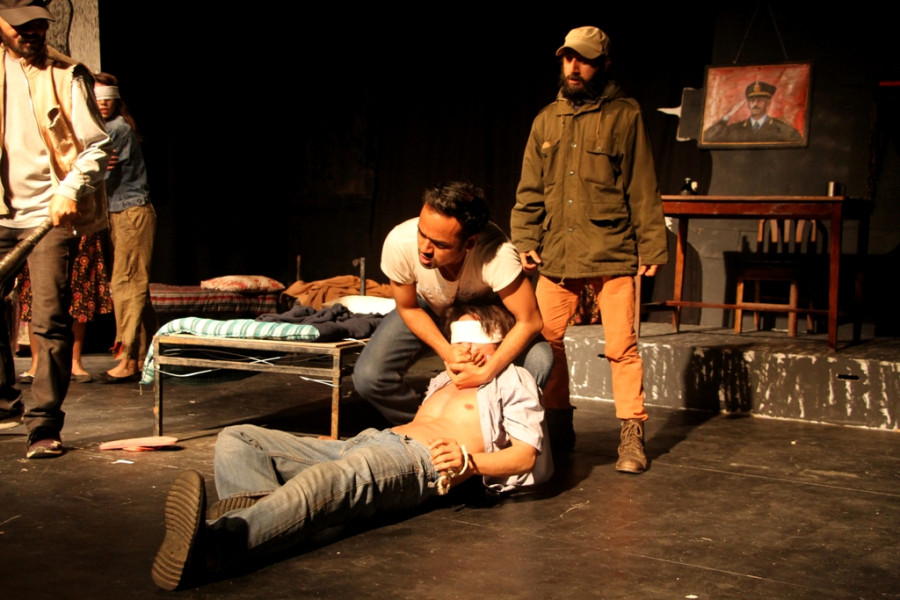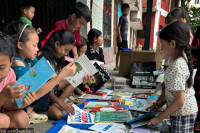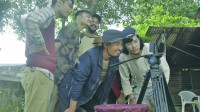Entertainment
One World Theatre’s adaptation of The Little School is a raw depiction of a 1970s Argentine concentration camp
Deborah Merola’s adaptation of The Little School wastes no time setting the tone for what is about to come for the next three hours.
Asmita Manandhar
The military is at Alicia’s door, knocking with a threatening sense of urgency. She tries to flee, taking the back door. As we watch, she runs away from the stage, but a group of armed men rise from among the audience, barring her way. As Alicia cowers and surrenders, the audience too is trapped inside her claustrophobic terror. Deborah Merola’s adaptation of The Little School wastes no time setting the tone for what is about to come for the next three hours.
During Argentina’s Dirty War, from 1970-1983, when a brutal military dictatorship ruled the country, Alicia Partnoy was among the many who were ‘disappeared’ by the state. After the end of the dictatorship in 1983, Partnoy published a memoir, The Little School, in 1986, detailing her experiences at a school that doubled as a concentration camp.
Partnoy herself now sits in the corner of a stage at the auditorium of the Kausi Theatre in Teku and recounts her memories as actors perform pieces of her life. She is a part of the performance—as a narrator—playing herself. Her younger version is played by Jenae Lien, who is blindfolded with her wrists tied, while her conscience has a life of its own and is played by Eva Victoria Leiva Partnoy, Alicia’s daughter.
The play, adapted and directed by Merola, is a raw depiction of Partnoy’s experience. When Partnoy narrates her experience, sitting at a small desk, flipping through the pages of her notebook and occasionally writing, it seems like she is picking apart the still-fresh skin from her wounds to get a closer look. When the actors, who play Partnoy and her friends, are pushed around, humiliated and tortured by the military, she quietly looks down and shakes her head.
As the audience, it is sometimes difficult to follow the reenactment of the torture and it is difficult not to wonder how Partnoy herself may have felt then and again, at this very moment, watching things unfold—this time, without the blindfold. Merola has seemingly carried out a very loyal adaptation of Partnoy’s original work, which is both to its benefit and its detriment.
As the play is primarily an account from a blindfolded prisoner, who is not even allowed to hold a conversation with fellow prisoners, Merola has done an admirable job of threading a visual story with actors who are just lying down on their beds for the most part of the performance.
As Partnoy’s mind wanders off on its own, when her body, sickened with constipation due to a lack of movement and starvation, she grapples with any semblance of life—even feeling the drops of water leaking from her prison roof. The play beautifully portrays the turmoil that takes place inside her head when her only resistance to her captors is a proof of existence—challenging the dictatorship by just staying alive through torture and humiliation.
Intermittently, a figure of death, played beautifully by Rose Bettina Schweitz, slides across the stage in her beautiful costume with slow choreographed steps, and is portrayed as the manifestation of that struggle to stay alive. In one scene, death mirrors the heroine’s gestures, depicting just how close the two have come, and how Partnoy has accepted death’s existence, almost like a companion. As death wanders around Partnoy and the other prisoners, it is almost like a seduction.
But two hours into the play, it seemed like Merola has indulged a little too much into a faithful adaptation. A number of scenes felt repetitive, taking away from the subtle nuance of the play. The performances of the actors didn’t falter during the entire play, but a lack of compact storytelling would’ve tired out the audience, had it not been for the powerful ending.
In typical Merola fashion, she doesn’t limit the performances to the stage alone but utilises the entire theatre, providing a sense of proximity to her audience with the characters. Although it may not be evident to the Nepali audience, the play uses props and costumes that symbolise the memory of the war. For instance, the women wear white scarves around their head during the climactic scene, which represents the Mothers of the Plaza de Mayo, a protest group consisting of Argentine mothers who wear white scarves and hold signs that carry the names of their families who were kidnapped and murdered during the country’s brutal regime.
The stage also carries artworks of Raquel Partnoy, Alicia’s mother. Additionally, her daughter Eva plays the role of her conscience when she was a prisoner in the Little School. This is a strong statement of how the war ravaged their family and the consequences that seep through the generations. It is also testament to the importance of memory in the healing process.
The prisoners’ turmoil and their quest to learn the whereabouts of their loved ones will hit home for Nepalis. The fear depicted by the armed men in ambiguous uniforms is something that Nepalis experienced during the decade-long armed conflict. Spread through 19 chapters, The Little School is more than just artistic expression; it is a roller-coaster ride through reality.




 13.12°C Kathmandu
13.12°C Kathmandu.jpg)










